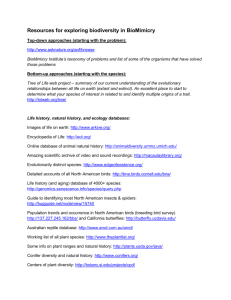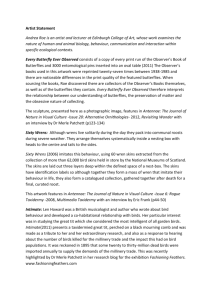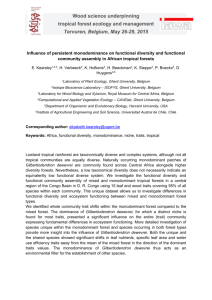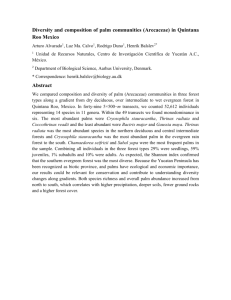Appendix A - Detailed field methodologies and sample design
advertisement
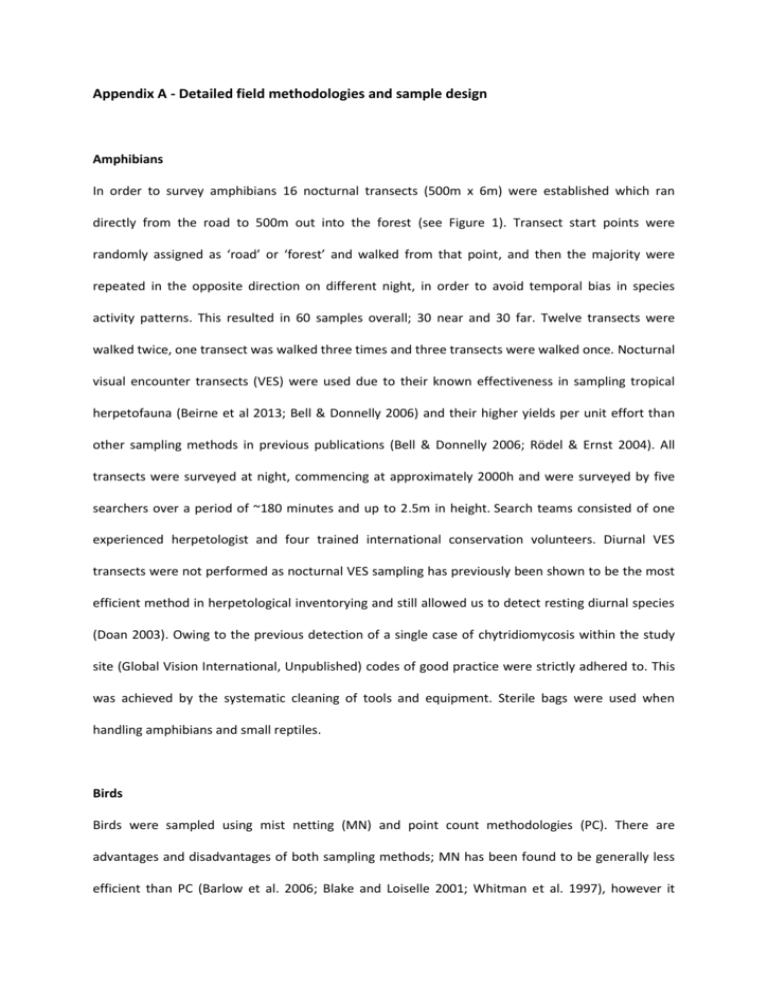
Appendix A - Detailed field methodologies and sample design Amphibians In order to survey amphibians 16 nocturnal transects (500m x 6m) were established which ran directly from the road to 500m out into the forest (see Figure 1). Transect start points were randomly assigned as ‘road’ or ‘forest’ and walked from that point, and then the majority were repeated in the opposite direction on different night, in order to avoid temporal bias in species activity patterns. This resulted in 60 samples overall; 30 near and 30 far. Twelve transects were walked twice, one transect was walked three times and three transects were walked once. Nocturnal visual encounter transects (VES) were used due to their known effectiveness in sampling tropical herpetofauna (Beirne et al 2013; Bell & Donnelly 2006) and their higher yields per unit effort than other sampling methods in previous publications (Bell & Donnelly 2006; Rödel & Ernst 2004). All transects were surveyed at night, commencing at approximately 2000h and were surveyed by five searchers over a period of ~180 minutes and up to 2.5m in height. Search teams consisted of one experienced herpetologist and four trained international conservation volunteers. Diurnal VES transects were not performed as nocturnal VES sampling has previously been shown to be the most efficient method in herpetological inventorying and still allowed us to detect resting diurnal species (Doan 2003). Owing to the previous detection of a single case of chytridiomycosis within the study site (Global Vision International, Unpublished) codes of good practice were strictly adhered to. This was achieved by the systematic cleaning of tools and equipment. Sterile bags were used when handling amphibians and small reptiles. Birds Birds were sampled using mist netting (MN) and point count methodologies (PC). There are advantages and disadvantages of both sampling methods; MN has been found to be generally less efficient than PC (Barlow et al. 2006; Blake and Loiselle 2001; Whitman et al. 1997), however it offers a method less implicated by observer bias. MN is a useful and standardised technique to compare understory avifaunal communities composed of cryptic species but is restricted by missing canopy avifauna, unless nets are raised into higher strata of the forest (Barlow et al. 2006; Blake and Loiselle 2000). This study combines both methods so the advantages of one might counteract the weaknesses of the other (Rappole et al. 1998). A total of 16 MN sites were established with a minimum buffer distance of at least 500m to account for individual home range overlap (Duca et al. 2006; Hansbauer et al. 2008). Nine sites were located within 0–350m from the road (near sites) and seven sites were located within 350–700m from the road (far sites). Birds were captured using four mist nets (12m long and 2.5m high) placed in a random array and with 30m between each net. Capture sites were surveyed for four consecutive days (weather permitting) and on average for five hours per day. Nets were opened on very first light (around 0530-0600h) and closed around 1030h to provide for higher capture rates during high activity periods (Blake 1992) and nets were checked every 25 minutes. PC surveys were conducted by one experienced staff member with a minimum of six months training and two to three international volunteers with a minimum of two weeks training. Points were located near to the road (1-350m) and far from the road (351-700m). In total 69 independent points were located (39 near and 30 far). The majority of points were repeated twice (median = 2, range = 1-4). Almost all counts were conducted beginning at 0600h and finishing mid-morning around 10:00h, to fit with periods of high avian vocal activity (Blake 1992; Mahood et al. 2012). Like mist netting, points were not surveyed in adverse weather when bird activity was heavily reduced; therefore a small number of counts had to be conducted late afternoon due to cancellations due to bad weather conditions for a few mornings (Blake 1992). Counts began for half of the days near to the road and for the other half of the days far from the road, as to reduce temporal bias related to bird activity patterns (Blake 1992). For each survey session three to four points were surveyed for the duration of 10 minutes per point after allowing for a 3 minute settling period upon arrival at the count site. All birds heard and seen were recorded at each point. If uncertainty regarding an individual’s identification existed, further efforts were made with sound recordings after the survey back at the field camp. Butterflies Six 400m transects were lightly cut to allow access to the trap locations. Five sites were located on each transect at distances of 50m, 100m, 200m, 300m and 400m from the road. Two traps were placed at each study site; comprising of one ground trap (1m above the ground) and one sub-canopy trap (10-15m from the ground) placed within 20m of each other. For data analysis sites that were considered ‘near’ sites were 50m, 100m and 200m from the road and ‘far’ sites were 300m and 400m away from the road. Traps were checked daily in the afternoons for nine consecutive days and bait replaced every 3 days to ensure effort in re-baiting traps was standardised without compromise of bait freshness (DeVries & Walla 2001; Hughes et al. 1998). Each transect was repeated twice. The number of individuals of each species for each distance was recorded. Individuals that were large enough and that did not possess transparent wings were marked using a non-toxic pen with a simple dot code on their upper wings to indicate trap height and distance where they were caught. Marking individuals allowed differentiation between recaptures and newly caught individuals in order to avoid pseudoreplication. The study targeted fruit-feeding Nymphalidae butterflies. Fruit-feeding guilds in this family have been used by previous studies for effectiveness in detecting ecological change due to their sensitivity to forest disturbance (Hamer et al. 2003; Lewis 2001). They are relatively easy to capture and can represent between 40 to 55% of total Nymphalid species richness in tropical forests (DeVries & Walla 2001). Using rotting banana bait prepared following the methods by DeVries and Walla (1999), butterflies were caught using Van Someren-Rydon traps measuring 1m in length and 0.25m in diameter as described by Austin and Riley (1995) and Hughes et al. (1998). This simple fruit-baited trap has been used successfully by previous studies on Nymphalidae butterflies in the tropics (Armstrong 2010; DeVries & Walla 2001; Hill et al. 2001; Hughes et al. 1998). Recording of data All amphibians encountered were identified in the field where possible (see Beirne & Whitworth (2011) for full indentification criteria and a complete list of identification resources used throughout the project). Unidentifiable individuals were anaesthetised with Lidocaine and fixed with 10% formalin then subsequently identified and stored at the Ecuadorian Natural Science Museum (MECN) in Quito. Butterflies were identified in the field where possible, using an unpublished set of field guides developed by GVI staff members since 2005. Birds were identified during MN sessions using Ridgely and Greenfield (2001) and Schulenberg (2000) in addition to this to assist with PC sound recordings. REFERENCES 1. Armstrong, C., 2010. The effect of forest edges on the community structure of tropical fruitfeeding butterflies. The Plymouth Student Scientist. 3(2), 3-17. 2. Austin, G.T., Riley, T.J., 1995. Portable bait traps for the study of butterflies. Tropical Lepidoptera, 6(1), 5-9. 3. Barlow, L. A., Mestre, M., Gardner, T.A., Peres, C.A., 2006. The value of primary, secondary and plantation forests for Amazonian birds. Biological Conservation 136(2), 212-223. 4. Beirne, C., Whitworth, A., 2011. Frogs of the Yachana Reserve. 5. Beirne, C., Burdekin, O., Whitworth, A., 2013. Herpetofaunal responses to anthropogenic habitat change within a small forest reserve in Eastern Ecuador. The Herpetological Journal, 23(4), 209-209. 6. Bell, K. E., Donnelly, M. A., 2006. Influence of forest fragmentation on community structure of frogs and lizards in northeastern Costa Rica. Conservation Biology, 20(6), 1750-1760. 7. Blake, J.G., 1992. Temporal variation in point counts of birds in a lowland wet forest in Costa Rica. The Condor, 94:265-275. 8. Blake, J.G., Loiselle, B.A., 2000. Diversity of birds along an elevational gradient in the Cordillera Central, Costa Rica. The Auk, (3), 663-686. 9. Blake, J.G., Loiselle, B.A., 2001. Bird assemblages in second-growth and old-growth forests, Costa Rica: Perspectives from mist nets and point counts. The Auk. 118(2), 304-326 10. DeVries, P.J., Walla, T.R., 1999. Species diversity in spatial and temporal dimensions of fruitfeeding butterflies from two Ecuadorian rainforests. Biological Journal of the Linnean Society, 68:333-353. 11. DeVries, P.J., Walla, T.R., 2001. Species diversity and community structure in neotropical fruit-feeding butterflies. Biological Journal of the Linnean Society, 74, 1-15. 12. Doan, T. M., 2003. Which methods are most effective for surveying rain forest herpetofauna?. Journal of herpetology, 37(1), 72-81. 13. Duca, C., Guerra, T.J., Marini, M. Â., 2006. Territory size of three Antbirds (Aves, Passeriformes) in an Atlantic Forest fragment in southeastern Brazil. Revista Bras. Zoo. 23(3), 692-698. 14. Hamer, K.C., Hill, J.K., Benedick, S., Mustaffa, N., Sherratti, T.N., Maryati, M., Chey, V.K., 2003. Ecology of butterflies in natural and selectively logged forests of northern Borneo: the importance of habitat heterogeneity. Journal of Applied Ecology. 40, 150-162. 15. Hansbauer, M.M., Storch, I., Leu, S., Nieto-Holguin, J., Pimentel, R.G., Knauer, F., Metzger, J.W., 2008. Movements of neotropical understory passerines affected by anthropogenic forest edges in the Brazilian Atlantic rainforest. Biological Conservation 141, 782-791. 16. Hill, J.K., Hamer, K.C., Tangah, J., Dawood, M., 2001. Ecology of tropical butterflies in rainforest gaps. Oecologia, 128, 294–302. 17. Hughes, J.B., Daily, G.C., Ehrlich, P.R., 1998. Use of fruit bait traps for monitoring of butterflies (Lepidoptera: Nymphalidae). Revista de Biología Tropical 18. Lewis, O.T., 2001. Effect of experimental selective logging on tropical butterflies. Conservation Biology, 15(2), 389-400. 19. Mahood, S.P., Lees, A.C., Peres, C.A., 2012. Amazonian countryside habitats provide limited avian conservation value. Biodiversity Conservation, 21, 385-405 20. Rappole, J. H., Winker, K., Powell, G. V., 1998. Migratory Bird Habitat Use in Southern Mexico: Mist Nets versus Point Counts (Hábitat Utilizado por las Aves Migratorias en México: Redes vs. Conteos de Punto). Journal of Field Ornithology, 635-643. 21. Ridgely, R. S., Greenfield, P. J., 2001. The Birds ofEcuador. Vol. II, field guide. Cornell University Press, Ithaca, NY. 22. Rödel, M. O., Ernst, R., 2004. Measuring and monitoring amphibian diversity in tropical forests. I. An evaluation of methods with recommendations for standardization. Ecotropica, 10, 1-14. 23. Schulenberg, T. S., Marantz, C. A., English, P. H., 2000. Voices of Amazonian Birds: Birds of the Rainforest of Southern Peru and Northern Bolivia. Cornell Laboratory of Ornithology. 24. Whitman, A. A., Hagan III, J. M., & Brokaw, N. V., 1997. A comparison of two bird survey techniques used in a subtropical forest. Condor, 955-965.
